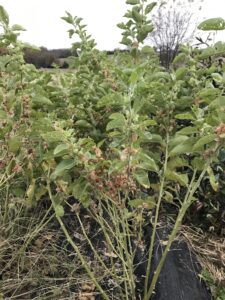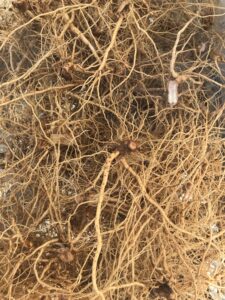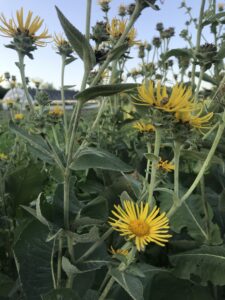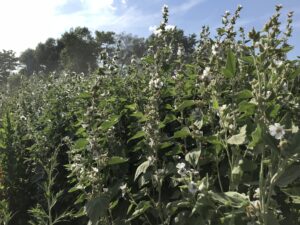Final report for FNC20-1230
Project Information
We have been farming with our current space since 2015, when we started growing vegetables as a market farm. We have since started to incorporate medicinal herbs, grains and expanded the vegetable production to a total of 3 acres. Since the beginning we have practiced sustainable land management with cover cropping, crop rotations, compost application and minimal tillage.
Most small scale farmers are focused on annual vegetable production to meet their community’s needs. However, the demand and need for US grown, medicinal plants is on the rise. Many people are interested in organic and fresh herbs grown by small producers, the same standard they want their food grown. This presents an opportunity for farmers to add medicinal roots into their crop plan to help satisfy the demand.
Planting medicinal roots can diversify the species on a farm, both with plants and beneficial insects. The perennial roots offer benefits such as windbreaks and erosion control, with the possibility of bringing back native prairie plants, like Echinacea. There is a need to educate farmers about medicinal root production as a source of income and to find ways to mechanize production, for it to be an efficient crop to grow. The research supported by this grant could work to educate more farmers and also find ways that medicinal roots can be grown efficiently in the Midwestern climates and soils.
- Set up 3 medicinal root trials (Ashwagandha, Elecampane and Marshmallow) in 80 foot beds and research production.
- Trial mechanized harvest and process data about yield.
- Do cost/ profit analysis to determine economic sustainability for farmers.
- Share research with on farm field presentation and in a talk with the Sustainable Agriculture Program at Johnson County Community College.
Research
This project will use our past research of medicinal roots to determine how to grow them on a larger scale. The plants will be started in trays in the greenhouse to ensure good germination, taken care of daily, and kept at a controlled temperature. The beds will be prepped with the rototiller and will be three 80-ft long beds at 4 ft wide. The dimensions of the beds are the standard at the farm, and the equipment is already set up to do the bed work this way. At Sacred Sun Farm, longer season crops are planted into paper mulch, to help retain soil moisture in the summer and keep weed pressure down. Each of the three beds will be mulched with paper before planting. Then the plants will be transplanted into their beds, 2 ft apart and two staggered rows, with one bed for each crop. This will give each plant enough space to grow and access to proper fertility, and will also use the space efficiently.
The three crops chosen are Ashwagandha, Marshmallow and Elecampane. They have all shown excellent growth in a single season, while also being well known and desirable herbs for herbalists and the community. There will be weekly evaluations of growth, weed management, and irrigation throughout the growing season. After the first killing frost in mid-October, the roots will be harvested using a bed lifter, washed and chipped. Then they will be spread on screens to dry until shelf stable. The profitability of the herbs will be determined after fresh and dry yields are counted and price points are made for each crop. After that point they can be sold, made into products or processed further into powders to aid in their profitability. Marketing and sales will be through our Farmer’s Markets and a wholesale herb store in Kansas City.
Reporting from the Field:
In the first year of this grant we are able to see the growth and resilience of these medicinal root crops. The Ashwagandha, Elecampane and Marshmallow were seeded into flats in the greenhouse on April 13th of 2020, with excellent germination from the Marshmallow and Elecampane within a week or two. The Ashwagandha was very slow to germinate and gain size, so it would be recommended to start this crop much earlier in the greenhouse the next season. The beds were tilled, fertilized and mulched with sheet paper in order to transplant Marshmallow and Elecampane on June 6th and Ashwagandha on June 12th. All crops were planted with two rows in a bed, 18 inches apart in the row and the rows 24 inches apart. The plants were staggered in their planting to give ample room between plants. They were monitored and their progress was tracked with pictures throughout the season. After the last frost, the Ashwagandha was harvested by hand on November 28th. We decided to harvest it by hand because the plants were much smaller than we thought and the yield fairly low. For an 80-ft bed of Ashwagandha, our crop yielded just 25 ounces of dried roots (this crop would be sold in dry form). We are looking forward to a better yield in the second year trial.
The top growth of the Elecampane and Marshmallow die back in the winter, and we pruned it back to make space for the new growth in the next spring. The 2020-2021 winter was mostly mild, with the exception of 10 or so days of very cold temperatures at the beginning of February, where some nights got as low as -10 degrees Fahrenheit. Despite these chilling temps all of the Marshmallow and nearly all of the Elecampane plants have come up in the spring of 2021. The new aerial growth has been tolerant of spontaneous cold dips and a very late spring snow in late April.
The Ashwagandha was seeded on 3/1/2021 and still took nearly a month to germinate, despite the constant warm temperatures in the greenhouse. After germination, the plants were potted up on 5/2/2021 and finally transplanted on 7/1/2021. These plants were much bigger at the time of transplant than the previous year. They were planted into mulch and grew well, reaching their full size of 36 inches. The three crops grew well throughout the 2021 season, with some loss of the Elecampane due to root rot. They were all harvested between Oct - Nov of 2021.
 Ashwagandha plant
Ashwagandha plant  Ashwagandha roots
Ashwagandha roots
 Elecampane plant in flower
Elecampane plant in flower  Marshmallow plants
Marshmallow plants
In our first attempt of growing Ashwagandha on this scale, it had a fairly poor yield, with an 80-ft bed only growing 25 ounces of root after dried. We are looking forward to trying this crop again for the second year and believe starting the plants many months earlier will help with the yield.
Our results for our medicinal root trials were measured by the number of pounds of each root that were produced in an 80-ft bed. The plants were 2 ft apart in standard rows, averaging about 80 plants per bed. The roots were dug by hand, washed with a sprayer, clipped into pieces with hand shears, then sprayed off again and left to air dry for a few hours. After they were air dried, the Ashwagandha and Elecampane roots were sent through the chipper. The Marshmallow roots were left to dry in the herb drying cabinet because of their mucilaginous texture, before we processed them with the chipper. The Ashwagandha and Elecampane roots were dried after being chipped. After the roots were all dry, they are shelf stable for up to 2-3 years. Some of the Ashwagandha roots were powdered to include in herbal supplements, but once powdered their shelf life goes down to 6 months.
Yields for each root:
Ashwagandha: 25 lbs fresh root / sold for $24 per lb fresh. It is sold for $27/lb dried and chipped, and $35/lb powdered.
Marshmallow: 38 lbs fresh root / sold for $14 per lb fresh. It is sold for $32/lb dried and chipped, and $34/lb powdered.
Elecampane: 20 lbs fresh root / sold for $14 per lb fresh. It is sold for $25/lb dried and chipped, and $26/lb powdered.
(the Elecampane roots were about 1 lb each, and because of some loss didn't have as much of a yield for the 80-ft row. It would've been the biggest yield if there hadn't been root rot loss). The cost per pound was generated by assessing the cost per crop and by information from other USA based medicinal herb growers prices.
Educational & Outreach Activities
Participation Summary:
We have posted updates on our Instagram page to share as we go, but haven't had any tours or presentations due to Covid-19 pandemic and also inconclusive information. We are looking forward to sharing our findings more completely in the fall of 2021.
In October of 2021 we hosted a tour on the farm that included a talk on our medicinal root research. There were about 25 people that came to this tour and were able to ask questions about the grant. At the time of the tour, we hadn't harvested all of the roots yet, so there are still findings to share with those that attended or are otherwise interested. We have also shared updates about the grant on our Instagram and Facebook accounts, and we look forward to sharing more photos and conclusions to our 1,500 followers there.
I look forward to being a resource to folks in the future when they have questions about growing any of these plants. I hope that by advertising our findings online, that other farmers will connect with us to talk about the possibilities of growing herbal roots for the North Central region and beyond.
Learning Outcomes
While it might be a bit tricky to get the hang of growing some of these medicinal roots, we learned that they can be a profitable addition to a small scale farm. You can really increase the efficiency of harvest with mechanization, but even with hand tools an 80-ft bed is manageable and adds diversity to small scale vegetable operation. A main advantage is that the crop is shelf stable for so long and can be stored. A main disadvantage is that it might be difficult to sell a single herb, unless you had a contract with a buyer in advance. Medicinal roots and herbs have been gaining popularity over the past decade, with an increase in awarness and desire every year so far, so it could be a good investment to incorporate some into a diverse growing operation.